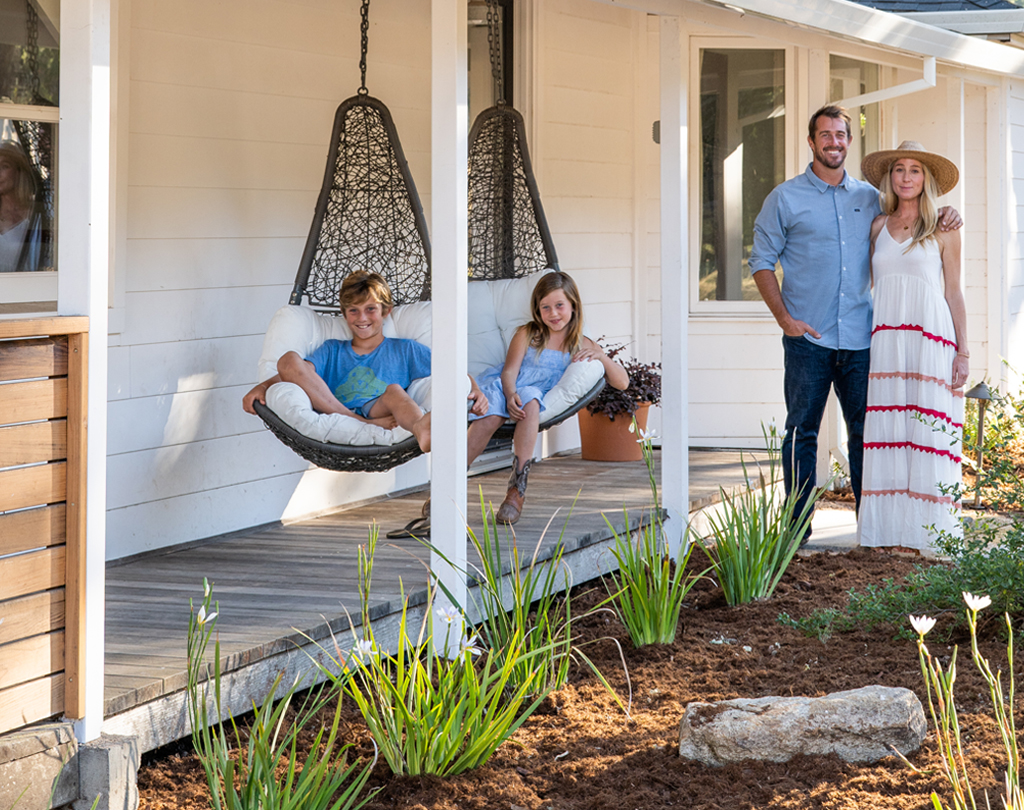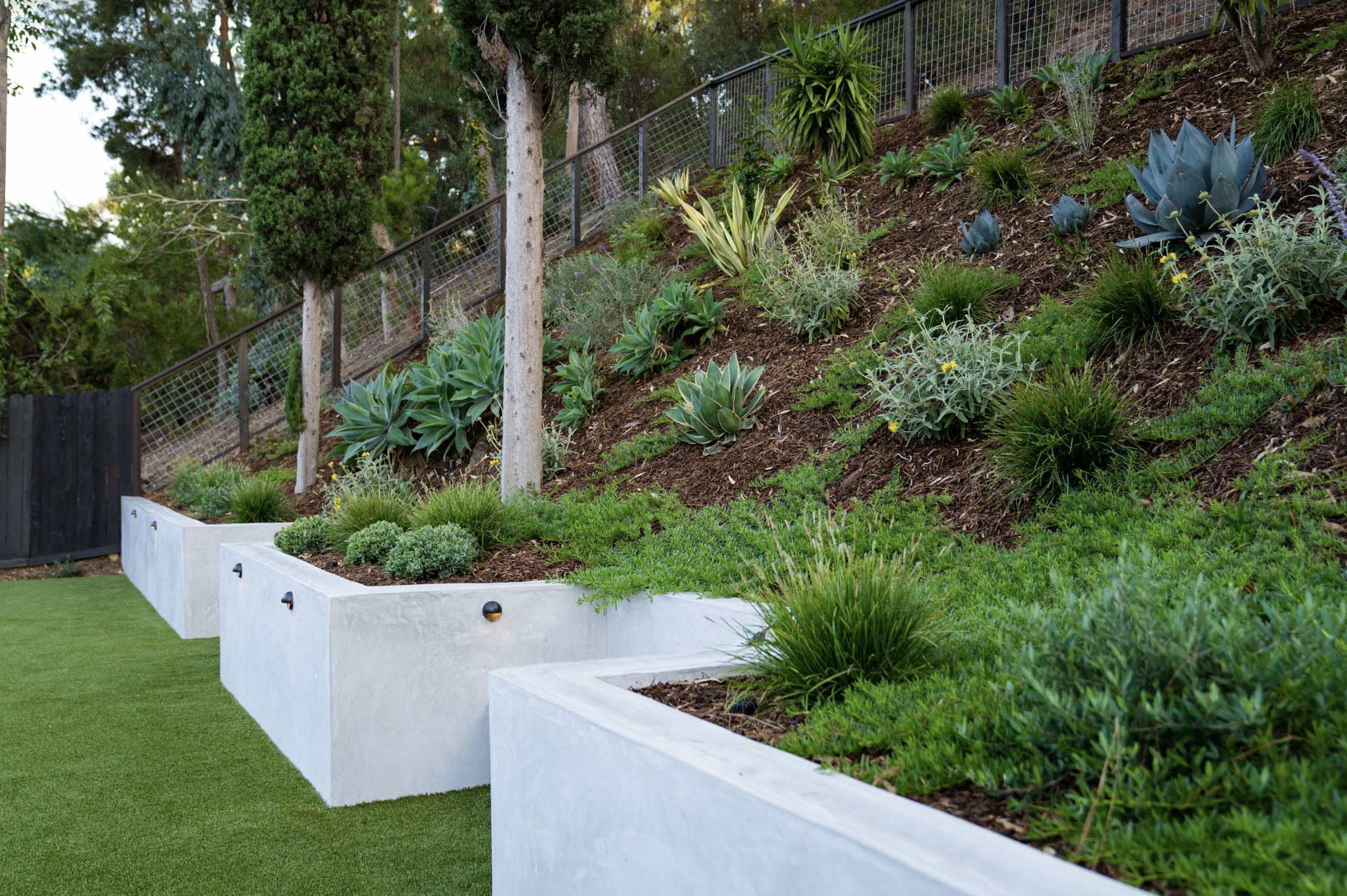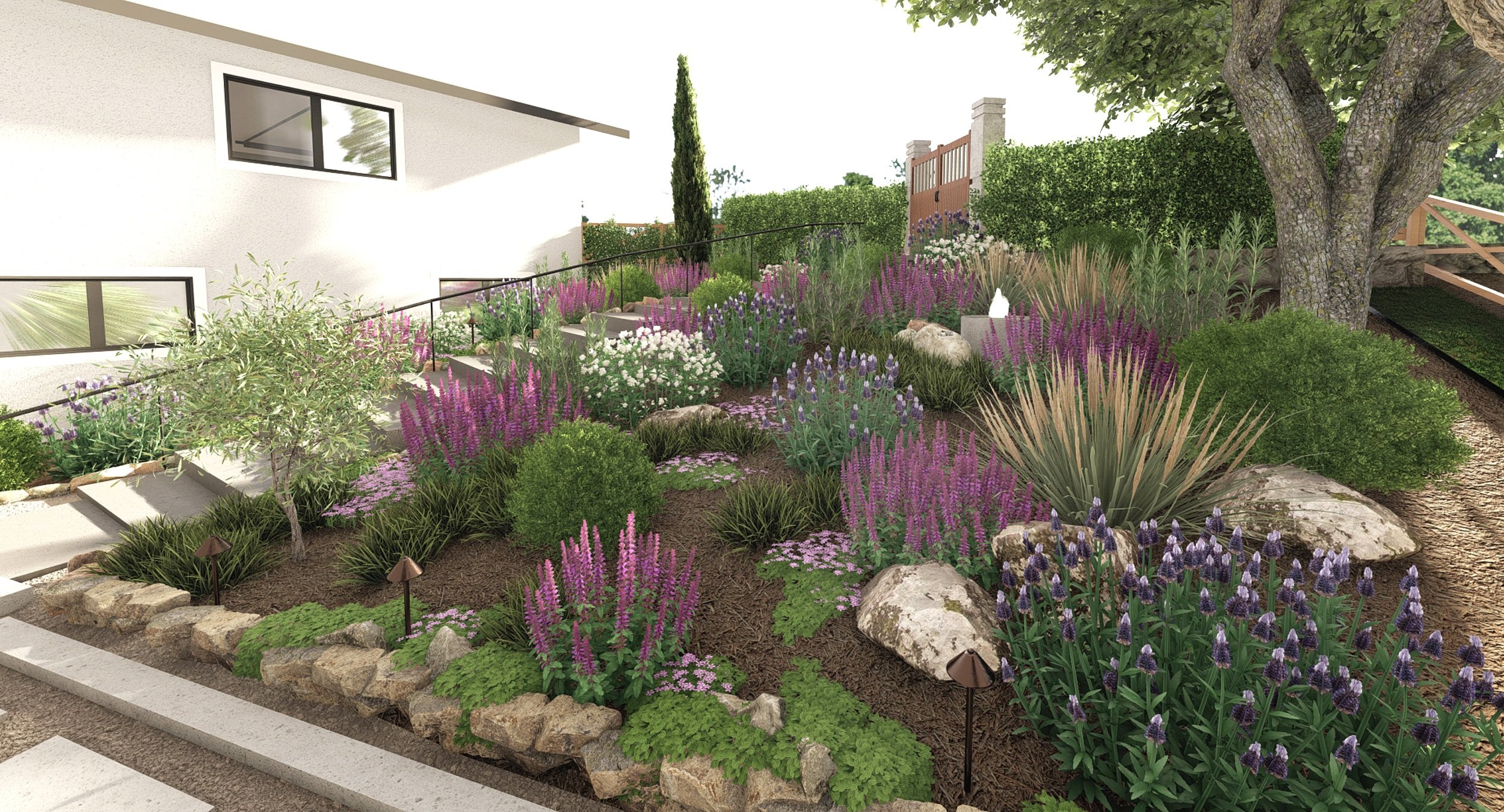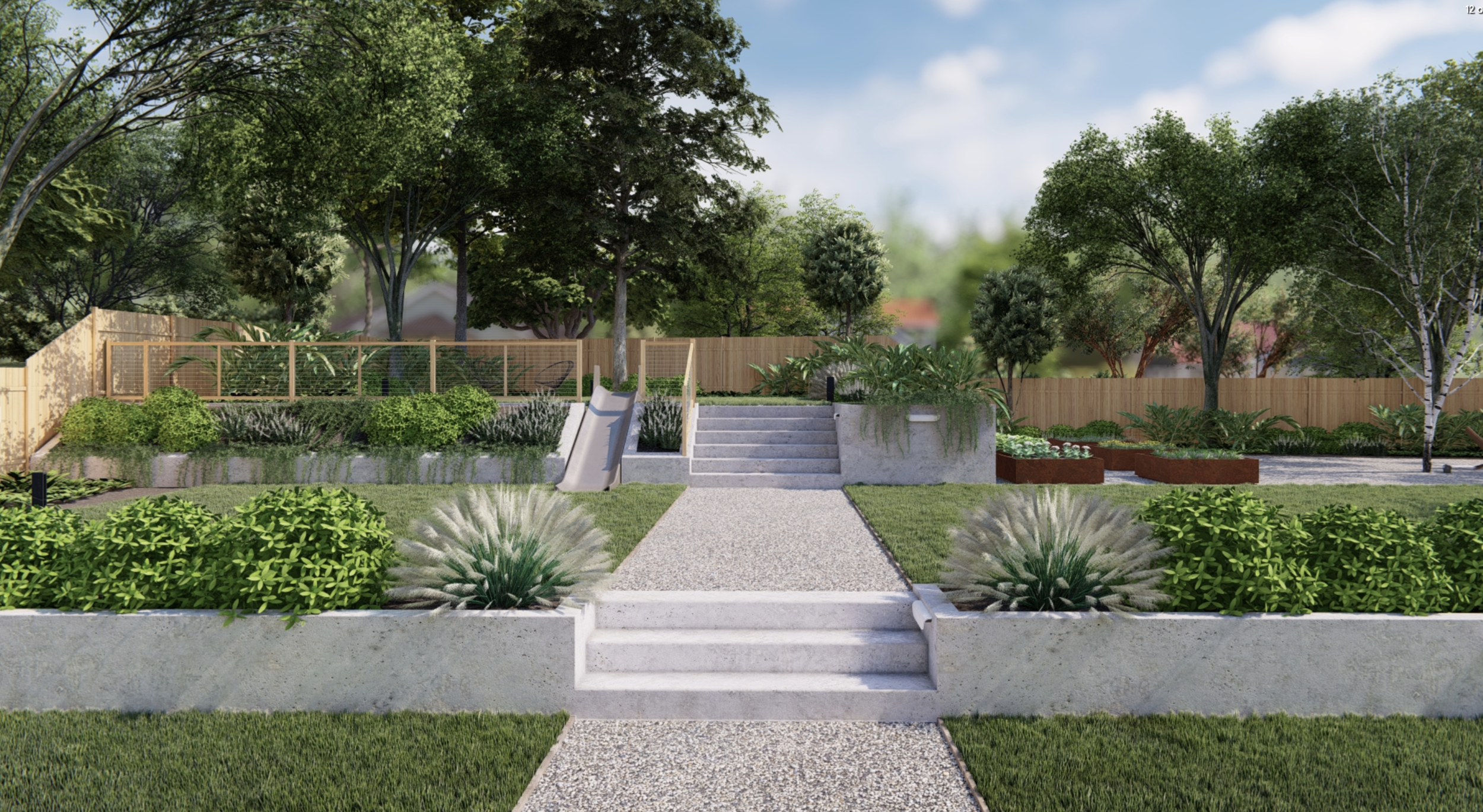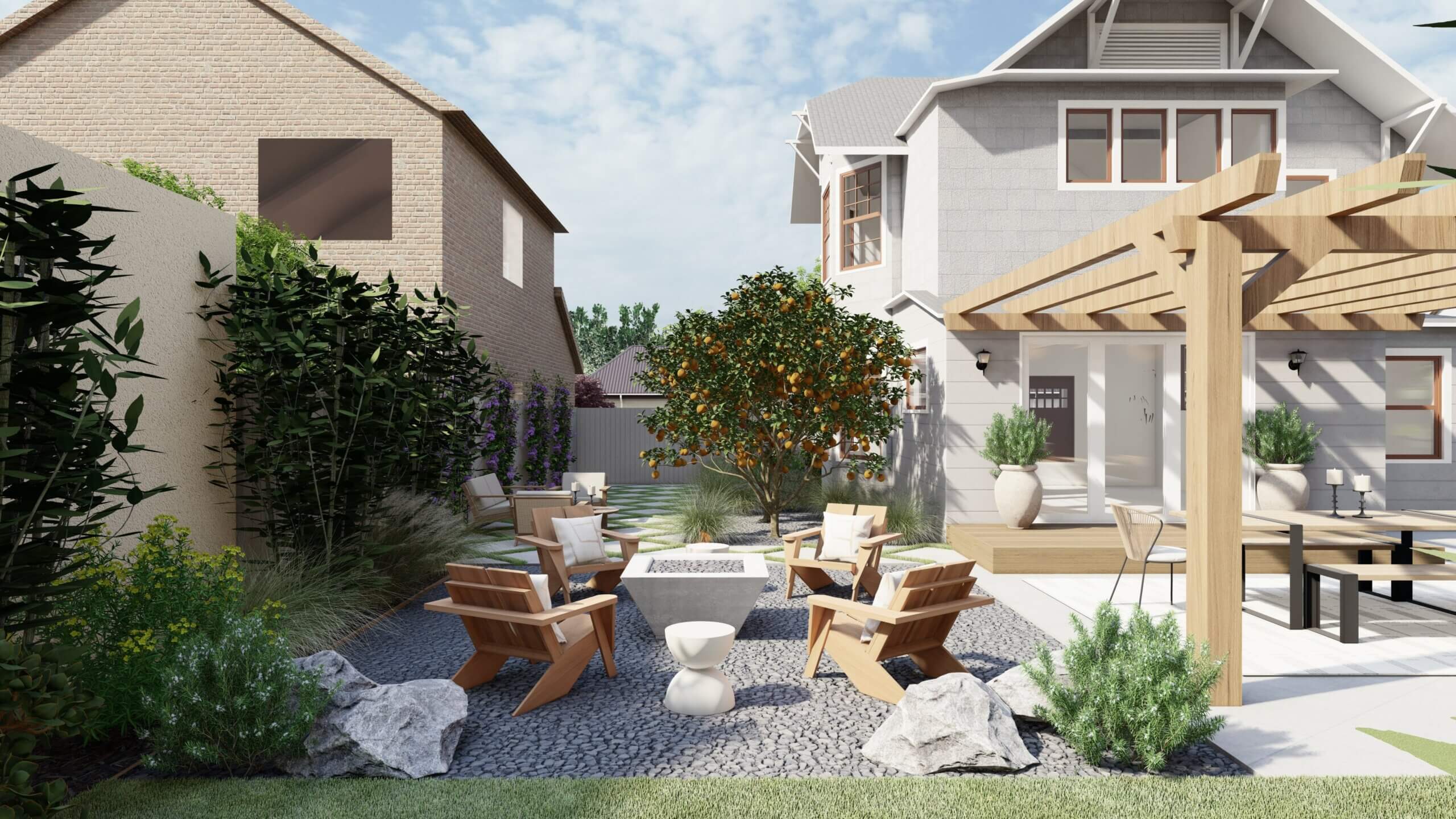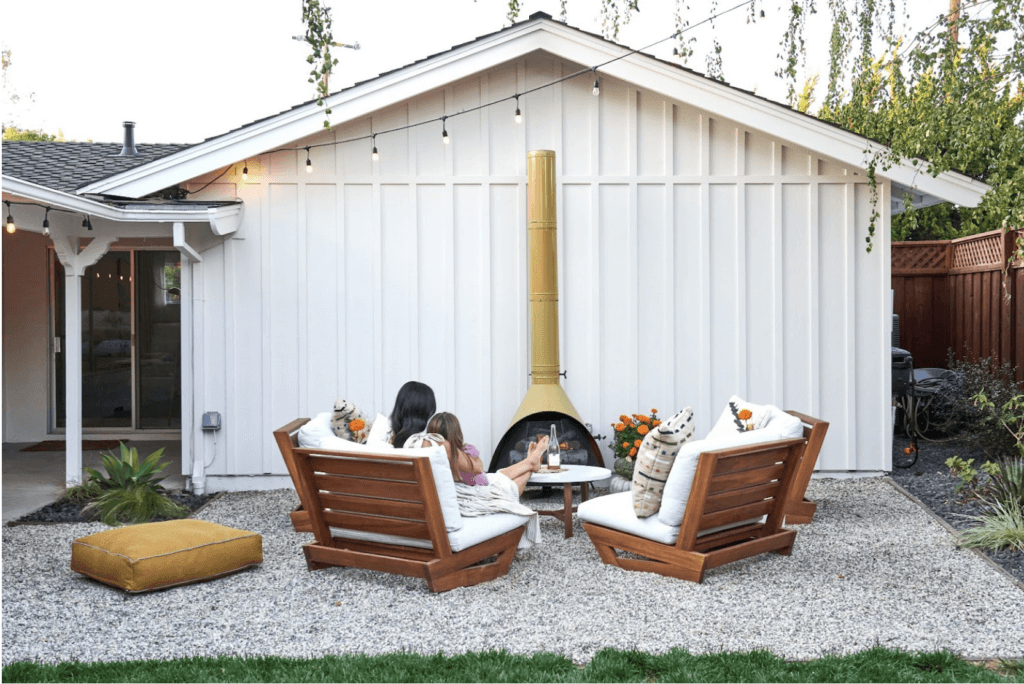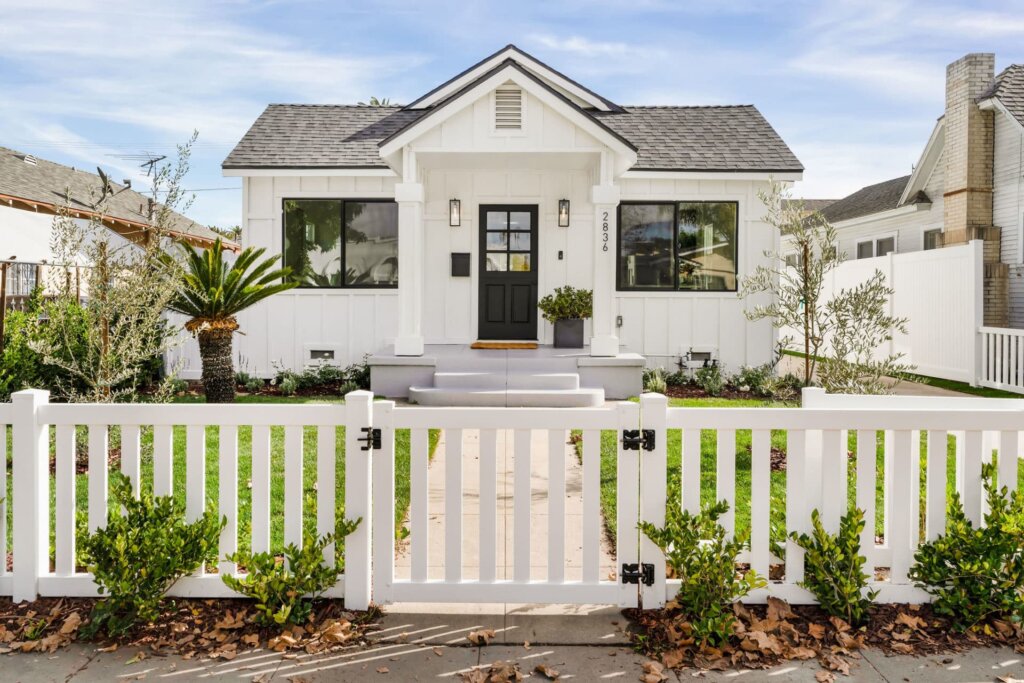
Ready to design your dream yard?
Get StartedA sloped Yardzen yard transformed by a retaining wall and smart landscape design decisions
Sloped terrain provides some of the most dramatic features in a landscape. Think of towering trees, distant views, and rhythmic planting drawing your eye uphill. Design can complement this drama: paths vanishing and reappearing, terraces slicing through slopes, decks defying gravity. Poetic? Absolutely. Easy to do? Not necessarily.
Should you be discouraged? No way! Hillside landscape design is achievable if you understand the challenges and set appropriate goals.
Challenges
Let’s start by reviewing some challenges that slopes present.
Access + Labor. Slopes, especially steep ones, are difficult to work on, and may be difficult to access. Hillside work takes longer to execute, and therefore costs more.
Irrigation. Water flows downhill, and water applied to plants on slopes is no exception. Keeping water in the root zone long enough for plants to absorb it can be difficult, and requires special measures.
Erosion. As rainfall flows downhill, it sweeps topsoil, mulch, and other surface materials along with it. This depletes soil quality, destabilizes slopes, and spreads debris around your yard.
Maintenance. As with installation labor, maintenance is extra challenging on slopes.
Fortunately, there are field-tested strategies to deal with each of these challenges (we’ll discuss them below). For now, just be aware that these issues apply to hillside designs.
Setting Goals for Your Hillside Yard
Now that we understand some of the challenges, let’s consider the goals that shape our hillside designs.
To Flatten, or Not to Flatten?
You can roughly categorize goals for hillside designs into two big buckets:
Flatten the slope
Don’t flatten the slope
Flattening is perhaps the most common request we receive regarding sloped yards, so let’s talk about that first.
…To Flatten
Clients frequently seek to flatten slopes to provide more space for playing, cooking, dining, or anything else that requires a level surface. This makes perfect sense from a functional perspective, but the work required to achieve this goal is often underestimated.
There are two ways to create flat space on an existing slope: make a terrace, or build a deck.
Terrace: Terracing works by moving soil around – a process called “grading” – to create a level plane in the middle of a slope. Generally, you cut the uphill half of the terrace into the slope, and pile the excavated soil on the downhill half, building retaining walls around all four sides to hold everything in place.
Deck: Grading can be avoided by floating a deck above a slope. The uphill edge of the deck rests on the ground, while the downhill edge is supported by tall posts anchored in the slope below.
Either approach is budget-intensive, which is something not all clients are aware of when they start the design process.
Terracing often requires heavy machinery for earth-moving, but if machinery can’t access the slope – a common issue – then soil must be moved by hand. Add in retaining wall expenses and difficult working conditions, and terraces quickly become costly.
As decks get larger and higher, they can trigger permitting, a process that adds cost and hassle. Factor in labor, materials, and providing access to the deck via stairs or paths, and deck costs also quickly accumulate. Decks may or may not cost less than terraces – the cost of either feature ultimately depends on the specific site and design.
Before we scare you off, let’s be clear: for many clients, terraces and hillside decks are a great idea and absolutely worth the investment. If this is you, it pays to know how to get the most bang for your buck.
Tips for Flattening Slopes:
Set priorities: Do a clear-eyed cost-benefit analysis at the outset of your project. Identify how important flat space is to you compared to other features in your design, and let that determine how much you are willing to invest in it.
Build enough, not extra: Design terraces and decks to comfortably accommodate their intended uses, but don’t go any larger than you need to. Oversizing or building multiple terraces or decks drains budget resources away from the rest of your design.
Keep it flexible: Make your flat spaces accommodate a variety of uses – this maxes out functionality while keeping built footprints manageable. Avoid built-in benches or other immobile features that cut through the middle of a flat space. Keep your layout flexible and open.
Work with what you’ve got: If terracing, look to build on existing flat spots within a slope. This minimizes grading. If existing paths – formal or informal – already exist on your slope, utilize them to avoid the expense of providing access to new flat spaces.
Go easy with walls: Limit the length of retaining walls to the bare minimum. Whenever possible, use cost-effective retaining wall materials like stacked stone, wood, or interlocking engineered blocks. If you don’t love these materials, consider planting above and below the walls to draw your eye elsewhere. Pro tip: let groundcover plants like Rosmarinus ‘Prostratus’ hang over the top of a wall.
Avoid permits: Determine local codes for wall height, deck height and square footage, and any other potential factors that could trigger permitting. If permits are required, you must get one, but try for a design that does not require a permit in the first place. We suggest keeping retaining walls under 3’ tall, and decks as low and modest as possible.
Consider access: If access for crews or equipment will be challenging, or if your slopes are extra steep, your costs will likely increase. Factor this in when considering how much you’d like to flatten.
Surgical strikes: For some clients, creating a handful of small terraces can be a cost-effective strategy. Spaces designed for just a bench or a small table and chairs require smaller, shorter walls, and can be created relatively cheaply. They can also take greater advantage of small flat zones within an existing slope than larger terraces. Small terraces cannot accommodate space-intensive uses like group dining or kitchens, but for meditative spaces or even small fire pit zones, they can be a great solution.
Abundant pollinator-supporting plants create a beautiful background in this sloped Yardzen yard
…NOT to Flatten
Enough about flattening. What else can we do with slopes?
Plant for Beauty. A well-composed planting design treats alternates focal moments of planting (specimen trees, compositions of shrubs and perennials) with open spaces occupied by low, spreading groundcover plants. The result should be a scenic resource for the rest of the yard to enjoy. Audit your existing slope for standout features, and use them as scenic anchors in your planting design. Fill the gaps with groundcover planting and the occasional boulder.
Plant for Stability. Rain quickly erodes bare soil. Plants’ roots hold soil in place, while their foliage slows water on its way downhill, coaxing it back into the ground. Rocks anchored in the slope achieve a similar effect. Use groundcover plants adapted to hillside conditions – ideally natives – to quickly spread and stabilize bare slopes. Take care to avoid any invasive species.
Playscapes. Slopes that terminate in flat areas can be used for play features. Stack boulders or stumps for a scramble, or embed a prefabricated slide into a slope. Play features embedded into the landscape look more cohesive than your average primary-colored play equipment, and they lend a little whimsy to a design. Whatever fun ideas you come up with, just make sure there is a safe, flat landing zone – a design should never put children at risk of falling down a slope.
Terraced planter boxes. Slopes with good sun exposure (west- or south-facing) can be great for vegetable boxes, especially when flat space is limited and needed for other, higher priority uses. Embed planter boxes into a slope so the uphill edge is fairly buried, while the downhill side sticks up 18” or so from the slope below. Provide stable space to work around the boxes, and a set of stairs to access them. As with terraces, be modest with your planter box aspirations – one or two boxes is often all you need to scratch the gardening itch.
Scenic Views. If your slope offers views, find a spot that balances easy accessibility, relatively mild slope angle, and scenic value, and shore it up with minimal retaining walls to create a lookout point. A comfy bench is all the furnishings you’ll need. The biggest expense for this feature is likely the path to get to it, so try to utilize existing routes when possible.
Water feature. Utilize sloped terrain and rocky outcroppings to create a natural water feature. Not only will it look and sound peaceful, it will provide valuable water resources for migrating birds and butterflies. Take care to keep your design – and the system required to pump water through it – from getting too elaborate.
Planting Best Practices
No matter what you do with your slopes, you’ll have at least some parts that stay sloped. For those areas, and any others you intend to plant, here are a few key planting tips.
Catch that water! Create small flat areas in a radius around new trees and plants to help detain water long enough for their roots to access it. Groundcover planting, rocks, and other elements that slow the flow of surface water are also helpful at making water available to plants.
Irrigate with drip. The slow feed of water is less likely to be lost downhill. Supplement with occasional overhead hand watering. This will encourage plants to spread laterally, covering more soil and improving slope stability.
Go Native: Because they’ve evolved to like local conditions, native plants tend to do the best with the least maintenance, and if placed appropriately, should require only minimal irrigation once established.
Be mindful with mulch. Mulch routinely gets swept downhill by rainfall. Shredded bark mulch can withstand erosion, but it ignites easily and is hazardous in areas prone to wildfires. Composted arbor mulch or wood chips offer greater fire resistance, but are more likely to slide downhill. Gravel mulch can withstand erosion better than bark mulch, but it too will wash downhill in heavy rain. Jute netting can be applied to hold mulch in place until it bonds with the soil. While functional, this can detract from the scenic value of a hillside.
Our advice: minimize mulch and lean on native groundcover planting to cover sloped terrain. It will offer more slope stability than mulch, resist and reduce erosion, and improve scenic value, while also providing habitat and a host of other ecosystem services in the process.
Final Thoughts on Hillside Landscaping
Slopes do present some challenges, but we encourage you to look at them positively – what design potential do your slopes offer you? Work with your slopes, not against them. By understanding both what they require and what they can offer, you’ll set yourself up for a successful design!
Ready to design your dream yard?
Get StartedFeatured Articles
How an Interior Designer Created “Outdoor Rooms” in Her Yardzen Yard

The Best Outdoor Cold Plunge Tubs & Ice Baths in 2024 (Chosen by Our Client...

Our Dreamiest Plunge Pool Yard Designs
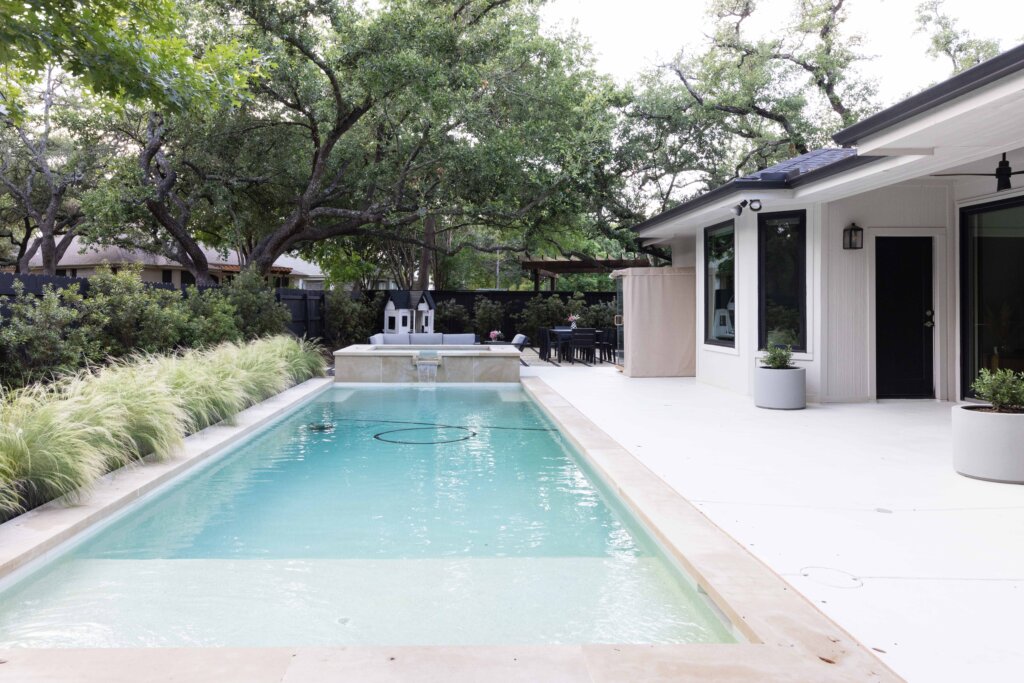
Our Favorite No-Grass Front Yard Ideas

